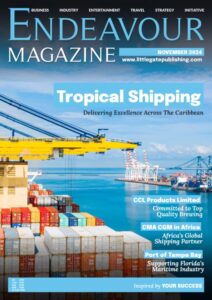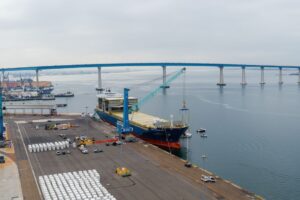At the heart of the Middle East, Jebel Ali Port serves as a premier gateway for trade, with over 80 weekly services arriving from numerous ports worldwide. These connections make the port crucial for supporting import and export markets under the management of DP World. Under DP World, the port has grown to serve 3.5 billion people in the region and many more globally. Today, it is the largest man-made harbour, offering essential maritime services that place it among the top 10 busiest ports in the world. Located 35 km southwest of Dubai, Jebel Ali Port functions as a leading deep-sea port across the Persian Gulf. Its history dates back over 50 years to the late 1970s, when Jebel Ali Port was first built. The port was designed to help supplement the facilities of other local ports, including Port Rashid, and to help the United Arab Emirates meet the rising demand for cargo imports and exports in the region.
Check out the article in the magazine below:
Owned and operated by DP World, the world’s largest marine terminal operator with 48 terminals and 13 new developments across 31 countries, the port plays a vital role in regional trade. DP World has developed trade across the UAE by providing integrated solutions that enable local and international companies to do business efficiently. Jebel Ali Port is part of DP World’s UAE portfolio, which also includes the Mine Rashid Cruise Terminal and Coastal Berth, and P&O Marinas. In addition, DP World manages Mina Al Hamriya Port in Dubai and oversees three zones: Jebel Ali Free Zone (JAFZA), National Industries Park (NIP), and Dubai Auto Zone (DAZ), along with Dubai Trade and World Security.
With the support of DP World, Jebel Ali Port has been voted ‘Best Seaport in the Middle East’ for 24 consecutive years, highlighting its vital role in delivering the port as a hub for trade within the Middle East. The port today plays a vital role in the Persian Gulf, Indian Subcontinent and African markets through its cargo operations. The port encompasses 1.4 million square meters (sqm) of total storage area, which includes 27 berths and a quayside depth of 15 metres. This depth allows very large and special cargo vessels to port at Jebel Ali, delivering great competitiveness for the port along international shipping lines.
One of the main things that sets Jebel Ali Port apart from its rivals is the high degree of specialism across the port’s storage and handling capabilities. The port can easily manage both cool and cold cargo with 9,665sqm of dedicated temperature-controlled space. This space allows customers to effectively store and move cargo that may be perishable or require specialised storage conditions. Across this storage space, many products, including chocolate, produce, cigarettes, alcohol, pharmaceutical products and cosmetics are frequently stored. These can be held in the cool storage between 10-20°C across three rooms, and the cold storage at a temperature between -29 to +13°C.
The port is also home to 4 terminals, which are vital in supporting the development of Jebel Ali Port’s cargo sector. Terminal 1 has the capacity of 9 million TEUs, making it one of the busiest terminals at the port, spanning 15 berths and 51 quays. This was the first terminal established at Jebel Ali port, and from this, the port has continued to expand to achieve its position as one of the leading ports across the globe. Terminal 2 encompasses 31 quay cranes that have a 6.5 million TEU capacity. Across this terminal, DP World is utilising state-of-the-art technology, which is seeking to decrease carbon emissions by 30% through sustainable practices. However, Terminal 3 is where DP World have taken the technological advancement of the port to the next level, with 5 berths and a 3.8 million TEU capacity delivered thanks to 19 automated quay cranes and 50 automated rail-mounted gantry yard cranes (ARMG). These automated cranes allow the port to handle greater capacities, including those from Ultra Large Container Vessels (ULCV), which can exceed 18.000 TEU capacities.
The final terminal is Terminal 4, which is currently in development, but is set to deliver the benchmark for world trade capabilities. The terminal is being designed to service the current and future cargo demands of the port, and on completion, is expected to add 2.4 million TEUs in capacity to the port’s infrastructure and cargo handling capacity. The development of Terminal 4 has been a vast development for DP World, with a particular focus on automotive cargo, and in August, the company announced that it was expanding its vehicle capacity at the port, specifically in Terminal 4, to meet the surging demand in cargo across the port.
The announcement outlines that the terminal upgrading would see storage increased by roughly 21% to enable port-wide optimisation and help deal with the increase in roll-on/roll-off (Ro/Ro) services seen in the first half of 2025. The expansion will see an 800-metre quay that can handle Ro/Ro services for three vessels simultaneously and will relocate the previous Ro/Ro operations from Terminal 1 to the new purpose-built Terminal 4. This upgrade will add 13,000 car equivalent units (CEUs), raising the total storage capacity of the port to 75,000 CEUs to cement the port’s position as a hub for automotive trade in the Middle East.
One of the other key facilities at Jebel Ali Port is the Logistics Capabilities Container Freight Station (CFS). The CFS provides 134,343sqm of storage space, which is located outside of Gate 2 of Jebel Ali Port. Here, a range of services will be provided, including Less than Container Load (LCL), handling transhipment cargo, Full Container Load (FCL) destuffing/stuffing, rework/consolidation operations, cross stuffing, weight reduction of container, export stuffing, and cargo delivery. This delivery of cargo also includes the Inter-Post Transfer, Internal Shifting and other additional services.
As Jebel Ali Port moves towards the future, DP World is focused on developing the port into a hub for technological advancement. It aims to achieve this through the launch of cutting-edge freight solutions at the port in partnership with Einride. The partnership outlines how the two companies will work together to accelerate the port’s transition to greener logistics through the development of electrical inter-terminal container flows. The development will see the electrification of its fleet of internal terminal vehicles (ITVs). Through the electrification of the vehicles, DP World hopes that, through its partnership with Einride across the port, it can reduce 14,600 tonnes of carbon dioxide equivalent (CO2e) annually when compared to a diesel operation.
The electrified fleet is to be deployed as part of a multi-phase rollout, which will integrate Einride’s full platform systems, including electric vehicles, charging infrastructure, and the AI-driven Einride Sage operating system. A full fleet is expected to be rolled out by 2026, which is capable of moving 2 million twenty-foot containers annually. This development highlights the port’s role in helping to achieve net-zero emissions by 2050 across the UAE through its implementation of an electric fleet over a diesel one. Thus, through DP World’s vital partnership and sustainability goals, the company is delivering Jebel Ali Port as a hub for technological advancement, ready to deliver vital operations underpinned by a firm commitment to sustainability.
Across Jebel Ali Port, DP World is set on delivering vital expansion development to meet the needs of the UAE’s cargo industry today, whilst expanding its facilities and infrastructure to meet the needs of the future. With the development of various terminals across the port, including Terminal 4, where its current development is largely based, DP World is able to deliver increased operations that meet the demands of its customers, whilst doing so with sustainability and technologically advanced efficiency in mind.








